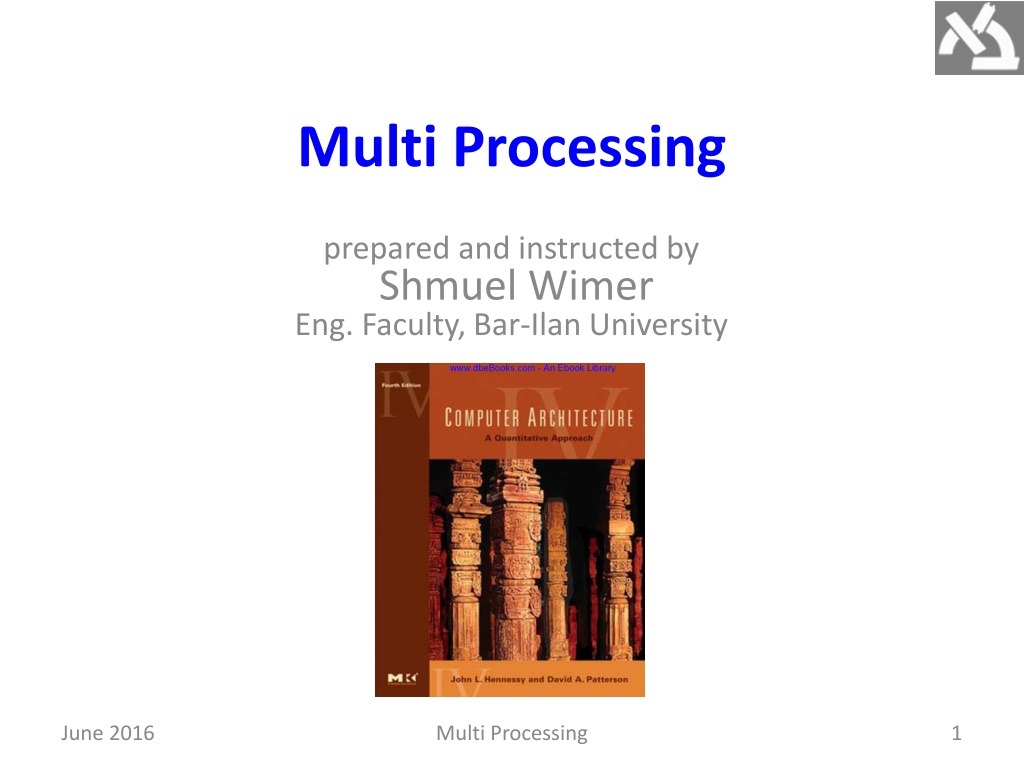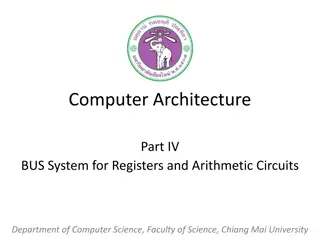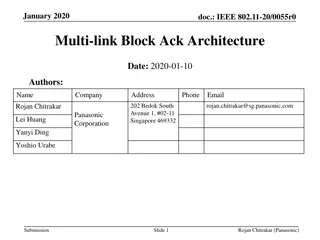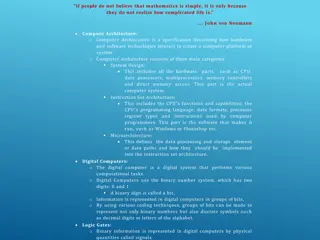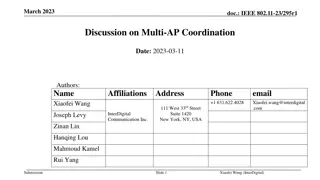Understanding Multi-Processing in Computer Architecture
Beginning in the mid-2000s, a shift towards multi-processing emerged due to limitations in uniprocessor performance gains. This led to the development of multiprocessors like multicore systems, enabling enhanced performance through parallel processing. The taxonomy of Flynn categories, including SISD, SIMD, MISD, and MIMD, highlights various approaches in multi-processing architectures. MIMD, particularly through multicore designs, has become the prevailing choice. To fully utilize MIMD multiprocessors, balancing the number of processors and threads/processes is essential for optimal execution. Thread-level parallelism offers flexibility and scalability, making multi-processing a pivotal aspect of modern computer architecture.
Download Presentation

Please find below an Image/Link to download the presentation.
The content on the website is provided AS IS for your information and personal use only. It may not be sold, licensed, or shared on other websites without obtaining consent from the author. Download presentation by click this link. If you encounter any issues during the download, it is possible that the publisher has removed the file from their server.
E N D
Presentation Transcript
Multi Processing prepared and instructed by Shmuel Wimer Eng. Faculty, Bar-Ilan University June 2016 Multi Processing 1
Introduction Since mid 2000s uniprocessor performance increase slows down: diminishing returns in exploiting ILP growing concern over power diminishing performance improvement of transistors Since 1990s designers sought a way to build servers and supercomputers achieving higher performance than a single microprocessor. A new era in computer architecture, where multiprocessors play a major role. June 2016 Multi Processing 2
Taxonomy Flynn [1966] proposed four categories: 1. Single Instruction stream, Single Data stream (SISD) Ordinary uniprocessor. 2. Single Instruction stream, Multiple Data streams (SIMD) Same instruction executed by multiple processors using different data streams. Each processor has its own data memory, but there is a single instruction memory and control processor, which fetches and dispatches instructions. Popular in multimedia, graphics, vector operations. June 2016 Multi Processing 3
3. Multiple Instruction streams, Single Data stream (MISD) Not practical, no commercial. 4. Multiple Instruction streams, Multiple Data streams (MIMD) Each processor fetches its own instructions and operates on its own data. Exploits thread-level parallelism , since multiple threads operate in parallel. Thread-level parallelism is more flexible than data-level parallelism and thus more generally applicable. June 2016 Multi Processing 4
MIMD is the most popular. The increasing silicon capacity enables placing multiple processors on a single die, called multicore. Multicore share L2, L3 cache or memory and I/O buses. 2000 s processors, as IBM Power5, Sun T1, and Intel Pentium D and Xeon-MP, are multicore. Multicore which relies on replication is advantageous over wide superscalar. Each processor is executing its own instruction stream. June 2016 Multi Processing 5
To take advantage of a MIMD multiprocessor with ? processors, we should have at least ?threads or processes to execute. The independent threads within a single process are typically identified by the programmer or created by the compiler. The threads may come from large-scale, independent processes scheduled and manipulated by OS. June 2016 Multi Processing 6
Centralized Shared-Memory June 2016 Multi Processing 7
With large caches, a single memory can satisfy the memory demands of a small number of processors. By using appropriate network it can be scaled to a few dozen processors. Because the main memory is symmetric to all processors, these are called Symmetric (shared- memory) Multiprocessors (SMPs). Due to the uniform access time from any processor, it is sometimes called Uniform Memory Access (UMA). Another group consists of multiprocessors with physically distributed memory. June 2016 Multi Processing 8
Distributed Memory To support many processors, memory is distributed among the processors rather than centralized. June 2016 Multi Processing 9
Otherwise the memory system would not be able to support the bandwidth demands without incurring excessively long access latency. The larger number of processors also raises the need for a high-bandwidth interconnect. Distributed memory is a cost-effective way to scale the memory bandwidth if most of the accesses are to the local memory in the node. A disadvantage is that communicating data between processors becomes complex, requiring more effort in the SW. June 2016 Multi Processing 10
Communication in Distributed Memory In Distributed Shared-Memory (DSM) architectures, communication occurs through a shared address space, as in a symmetric shared-memory. The physically separate memories are addressed as one logical address space, so memory reference can be made by any processor to any memory location. Alternatively, the address space can consist of multiple, logically disjoint, private address spaces, which cannot be addressed by a remote processor. June 2016 Multi Processing 11
The same physical address in different processors refers to different locations in different memories. For a multiprocessor with a shared address space, the address space is used to communicate data implicitly via load and store operations. Multiprocessor communicates data by explicitly passing messages among the processors, multiprocessors. with multiple address spaces called message-passing Amdahl s Law makes parallel processing challenging. A hurdle is the limited parallelism in programs. June 2016 Multi Processing 12
Example. We want to achieve a speedup of 80 with 100 processors. What fraction of the original computation can be sequential? The program operates in two modes: parallel with all processors fully used (enhanced) or serial with only one processor in use. Answer. Amdahl s Law states 1 Speedup = Frac parallel Speedup parallel+(1 Frac parallel) June 2016 Multi Processing 13
0.8 Frac parallel + 80 1 Frac parallel = 1 Frac parallel = 0.9975! To achieve a speedup of 80 with 100 processors, only 0.25% of original computation can be sequential. To achieve linear speedup, the entire program must be parallel with no serial portions. Not realistic. June 2016 Multi Processing 14
A second hurdle arises from the relatively high cost of communications, from 50 to over 1000 clock cycles. It depends on the communication mechanism, the type of interconnection network, and the scale of the multiprocessor. Symmetric shared-memory machines support the caching of both shared and private data. Private data are used by a single processor. June 2016 Multi Processing 15
shared data are used by multiple processors, providing communication among the processors through reads and writes of the shared data. When a private item is cached, since no other processor uses the data, the program behavior is identical to uniprocessor. When shared data are cached, the shared value may be replicated in multiple caches. June 2016 Multi Processing 16
Advantages: Reduction in access latency Reduction in required memory bandwidth Reduction in contention that exists for shared data items read by multiple processors simultaneously. New problem: cache coherence. The view of memory held by two different processors is through their individual caches, which could end up seeing two different values. June 2016 Multi Processing 17
Cache Coherence A memory system is coherent if: 1. Preserves program order. A read by ?1 to ? after a write by ?1 to ?, with no intervening writes of ? by ?2, always returns the value written by ?1. It is expect also in uniprocessors. 2. A read by ?1 to ?after a write by ?2 to ? returns the value written by ?2if the read and write are sufficiently separated in time and no other writes to ? interven. June 2016 Multi Processing 18
If a write of ? on ?1 and read of ? on ?2are insufficiently separated in time, it may be impossible to ensure that ?2read returns ? written by ?1, since ? may not have left ?1yet. 3. Serialization.Two writes to the same location by any two processors are seen in the same order by all processors. The issue of exactly whena written value must be seen by a reader is defined by memory consistency model. We assume that a write does not complete (allow next write) until all processors see the effect of that write. June 2016 Multi Processing 19
We assume that the processor does not change the order of any write with respect to any other memory access (different memory locations). These two conditions mean that if a processor writes location ? followed by location ?, any processor seeing the new value of ? must also see the new value of ?. These restrictions allow the processor to reorder reads, but forces it to finish a write in program order. June 2016 Multi Processing 20
Memory Consistency strict consistency x sequential consistency v strict consistency v sequential consistency v June 2016 Multi Processing 21
Consistency Implications Sequential consistency allows 0 or 1 processes to be killed, but not both. P1 will only try to kill P2 if P1 s read to B occurs before P2 s write to B. The in-order execution of memory events implies that P1 s write to A must come before P2 s read of A. June 2016 Multi Processing 22
P1 and P2 try to kill each other, disallowed by sequential model. ? ? June 2016 Multi Processing 23
Sequential consistency must delay all memory operations following a write until the write is observed by all other clients. ? ? June 2016 Multi Processing 24
Can also be solved by speculation. Execute memory instructions subsequent to write, but hold commitment long enough after write to ensure that all processor cores observe the write. If the write observed conflicts with an early read, that instruction s commitment must be halted, its results must be discarded, and the instruction must be re executed in light of the new data. June 2016 Multi Processing 25
Coherence Enforcement A program running on multiple processors will normally have copies of the same data in several caches. The protocols to maintain coherence for multiple processors are called cache coherence protocols. Cache coherence protocol implementation must track the state of any sharing of a data block. Two classes of protocols. A directory based keeps the sharing status of a block of physical memory in one location, called the directory (not discussed). June 2016 Multi Processing 26
Snooping protocols have no centralized state. Every cache having a copy of a block of physical memory has a copy of the block s sharing status (status bits). All caches are accessible via a bus or switch, and all cache controllers snoop (monitor) to determine whether or not they have a copy of a block that is requested for access. Write invalidate protocol is a method ensuring that a processor has exclusive access to a data item before it writes that item, invalidating other copies on a write. June 2016 Multi Processing 27
Exclusive access ensures that no other readable or writable copies of an item exist when the write occurs. All other cached copies of the item are invalidated. Consider a write followed by a read by another processor. June 2016 Multi Processing 28
If two processors do attempt to write the same data simultaneously, one of them wins the race, invalidating the other processor s copy. To complete its write the other processor must obtain a new copy of the data, now containing the new value. This protocol enforces write serialization. The alternative to an invalidate protocol is to update all the cached copies of a data item when that item is written. This type of protocol is called a write update or write broadcast protocol. June 2016 Multi Processing 29
Write Invalidate Implementation For invalidation, the writing processor acquires bus access and broadcasts the address to be invalidated. All processors continuously snoop on the bus, watching the addresses. The processors check whether the address on the bus is in their cache. If so, the corresponding data in the cache are invalidated. If two processors attempt to write shared blocks at the same time, their attempts to broadcast invalidation are serialized when they arbitrate for the bus. June 2016 Multi Processing 30
We also need to locate a data item when a cache miss occurs. In a write-through cache, it is easy to find the recent value in the memory. The problem of finding the most recent data value in write-back cache is harder, since most recent data item is in a cache. Write-back caches use snooping both for cache misses and for writes. Each processor snoops every address placed on the bus. If it finds to have a dirty copy of the requested block, it provides that block in response to the read request and aborts the memory access. June 2016 Multi Processing 31
Snooping Protocol Example A snooping coherence protocol is implemented by incorporating a finite state controller in each node. The controller responds to requests from the processor and the bus, changing the state of the selected block and using the bus to access data or to invalidate it. The protocol has three states: invalid, shared, and modified (MSI) . The shared state indicates that the block is potentially shared. The modified state indicates that the block has been updated in the cache, implying that it is exclusive. June 2016 Multi Processing 32
Cache block state transitions for CPU requests June 2016 Multi Processing 33
Cache block state transitions for bus requests June 2016 Multi Processing 34
This protocol is for a write-back cache but is easily modified for a write through cache. June 2016 Multi Processing 35
The normal cache tags can be used to implement the snooping and the valid bit to implement invalidation. Read misses, whether generated by an invalidation or by some other event, are also straightforward since they simply rely on the snooping capability. Writes like to know whether any other copies of the block are cached because otherwise the write need not be placed on the bus in a write-back cache. Not sending the write on the bus reduces both the time taken by the write and the required bandwidth. June 2016 Multi Processing 36
A bit indicating whether the block is shared enables to decide whether a write must generate an invalidate. The cache generates an invalidation on the bus and marks the block as exclusive. The processor with the sole copy of a cache block is normally called the ownerof the cache block. Since our snooping cache also sees any misses, it knows when the exclusive cache block has been requested by another processor and the state should be made shared. June 2016 Multi Processing 37
Shared Memory Example Assumes A1 and A2 map to same cache block June 2016 Multi Processing 38
Performance of SMP (Shared Memory) Misses arising from inter-processor communication, called coherence misses, are broken into two sources. The first is true sharing misses,arising from data communication through cache coherence mechanism. In an invalidation-based protocol, the first write by a processor to a shared block causes an invalidation to establish ownership of that block. Additionally, when another processor attempts to read a modified word in that cache block, a miss occurs and the resultant block is transferred. June 2016 Multi Processing 39
The second is false sharing, occurs when a block is invalidated (subsequent reference causes a miss) because some word in the block, other than the read one, is written into (at another processor). If written and read words are different and the invalidation does not cause a new value to be communicated, but only causes an extra cache miss, then it is a false sharing miss. In a false sharing miss, the block is shared, but no word in the cache is actually shared. The miss is always true for single word block size. June 2016 Multi Processing 40
Example: The words ?1 and ?2 are in the same cache block, which is in the shared state in the caches of both ?? and ??. For the following sequence of events, identify each miss as a true or a false sharing miss, or a hit. 1. True sharing miss, since ?1 is in ?? and needs to be invalidated from ??. June 2016 Multi Processing 41
2. False sharing miss, since ?2 was invalidated by the write of ?1 in P P1 1, but that value of ?1 is not used in ??. 3. False sharing miss, since the block containing ?1 is marked shared due to the read in ??, but ?? did not read ?1. The cache block containing ?1 will be in the shared state after the read by P2; a write miss is required to obtain exclusive access to the block. June 2016 Multi Processing 42
4. False sharing miss for the same reason as step 3. 5. True sharing miss, since the value being read was written by P P2 2. The role of coherence misses is more significant for tightly coupled applications that share significant amounts of user data. June 2016 Multi Processing 43
The Problem with MSI A block is in no cache to begin with Problem: On a read, the block immediately goes to Shared state although it may be the only copy to be cached (i.e., no other processor will cache it) Why is this a problem? Suppose the cache that read the block wants to write to it at some point It needs to broadcast invalidate even though it has the only cached copy! If the cache knew it had the only cached copy in the system, it could have written to the block without notifying any other cache saves unnecessary broadcasts of invalidations June 2016 Multi Processing 44
The Solution: MESI Idea: Add another state indicating that this is the only cached copy and it is clean. Exclusive state Block is placed into the exclusive state if, during BusRd, no other cache had it Wired-OR shared signal on bus can determine this: snooping caches assert the signal if they also have a copy Silent transition Exclusive Modified is possible on write June 2016 Multi Processing 45
June 2016 Multi Processing 46
